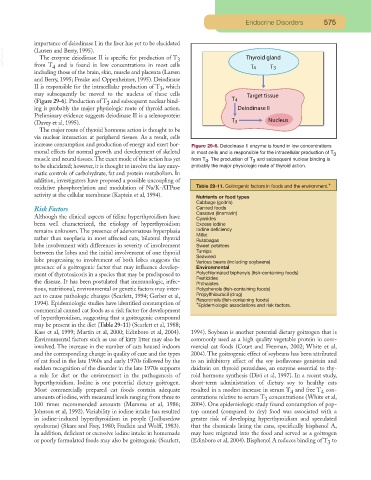Page 556 - Small Animal Clinical Nutrition 5th Edition
P. 556
Endocrine Disorders 575
importance of deiodinase I in the liver has yet to be elucidated
VetBooks.ir (Larsen and Berry, 1995). 3
The enzyme deiodinase II is specific for production of T
from T and is found in low concentrations in most cells
4
including those of the brain, skin, muscle and placenta (Larsen
and Berry, 1995; Freake and Oppenheimer, 1995). Deiodinase
II is responsible for the intracellular production of T , which
3
may subsequently be moved to the nucleus of these cells
(Figure 29-6). Production of T and subsequent nuclear bind-
3
ing is probably the major physiologic route of thyroid action.
Preliminary evidence suggests deiodinase II is a selenoprotein
(Davey et al, 1995).
The major route of thyroid hormone action is thought to be
via nuclear interaction at peripheral tissues. As a result, cells
increase consumption and production of energy and exert hor- Figure 29-6. Deiodinase II enzyme is found in low concentrations
monal effects for normal growth and development of skeletal in most cells and is responsible for the intracellular production of T 3
muscle and neural tissues.The exact mode of this action has yet from T . The production of T and subsequent nuclear binding is
4
3
to be elucidated; however, it is thought to involve the key enzy- probably the major physiologic route of thyroid action.
matic controls of carbohydrate, fat and protein metabolism. In
addition, investigators have proposed a possible uncoupling of
oxidative phosphorylation and modulation of Na/K-ATPase Table 29-11. Goitrogenic factors in foods and the environment.*
activity at the cellular membrane (Kaptein et al, 1994). Nutrients or food types
Cabbage (goitrin)
Risk Factors Canned foods
Cassava (linamarin)
Although the clinical aspects of feline hyperthyroidism have Cyanides
been well characterized, the etiology of hyperthyroidism Excess iodine
remains unknown. The presence of adenomatous hyperplasia Iodine deficiency
Millet
rather than neoplasia in most affected cats, bilateral thyroid Rutabagas
lobe involvement with differences in severity of involvement Sweet potatoes
between the lobes and the initial involvement of one thyroid Turnips
Seaweed
lobe progressing to involvement of both lobes suggests the Various beans (including soybeans)
presence of a goitrogenic factor that may influence develop- Environmental
ment of thyrotoxicosis in a species that may be predisposed to Polychlorinated biphenyls (fish-containing foods)
Pesticides
the disease. It has been postulated that immunologic, infec- Phthalates
tious, nutritional, environmental or genetic factors may inter- Polyphenols (fish-containing foods)
act to cause pathologic changes (Scarlett, 1994; Gerber et al, Propylthiouracil (drug)
Resorcinols (fish-containing foods)
1994). Epidemiologic studies have identified consumption of *Epidemiologic associations and risk factors.
commercial canned cat foods as a risk factor for development
of hyperthyroidism, suggesting that a goitrogenic compound
may be present in the diet (Table 29-11) (Scarlett et al, 1988;
Kass et al, 1999; Martin et al, 2000; Edinboro et al, 2004). 1994). Soybean is another potential dietary goitrogen that is
Environmental factors such as use of kitty litter may also be commonly used as a high quality vegetable protein in com-
involved. The increase in the number of cats housed indoors mercial cat foods (Court and Freeman, 2002; White et al,
and the corresponding change in quality of care and the types 2004). The goitrogenic effect of soybeans has been attributed
of cat food in the late 1960s and early 1970s followed by the to an inhibitory effect of the soy isoflavones genistein and
sudden recognition of the disorder in the late 1970s supports daidzein on thyroid peroxidase, an enzyme essential to thy-
a role for diet or the environment in the pathogenesis of roid hormone synthesis (Divi et al, 1997). In a recent study,
hyperthyroidism. Iodine is one potential dietary goitrogen. short-term administration of dietary soy to healthy cats
Most commercially prepared cat foods contain adequate resulted in a modest increase in serum T and free T con-
4
4
amounts of iodine, with measured levels ranging from three to centrations relative to serum T concentrations (White et al,
3
100 times recommended amounts (Mumma et al, 1986; 2004). One epidemiologic study found consumption of pop-
Johnson et al, 1992). Variability in iodine intake has resulted top canned (compared to dry) food was associated with a
in iodine-induced hyperthyroidism in people (Jodbasedow greater risk of developing hyperthyroidism and speculated
syndrome) (Skare and Frey, 1980; Fradkin and Wolff, 1983). that the chemicals lining the cans, specifically bisphenol A,
In addition, deficient or excessive iodine intake in homemade may have migrated into the food and served as a goitrogen
or poorly formulated foods may also be goitrogenic (Scarlett, (Edinboro et al, 2004). Bisphenol A reduces binding of T to
3

